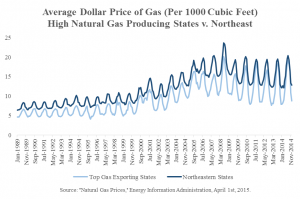Natural Gas Supply and Demand — A Structural Problem in the Northeast
The cost of residential heating and cooling in the Northeast is comparatively high, with no clear end in sight. Fracking regulations and outright bans are pushing whole industries out of densely populated municipalities as well as entire states such as New York, where the extraction methodology has met strong opposition at each level of government. Even the importation of natural gas from other states such as Pennsylvania — which remains very active in tapping Marcellus shale deposits — is becoming difficult, with neighborhood groups and city governments opposing pipelines and other forms of infrastructure to support burgeoning energy demand.
Vocal adversaries of gas withdrawals and transport site two reasons for supporting gas restrictions:
- the danger to the environment through the practice of fracking and the construction of gas pipes
- falling property value due to aesthetic degradation from pipelines around residential areas
Unfortunately these opponents still pay a hefty premium on limiting the availability of gas through higher residential heating and cooling prices. Below, northeastern states are compared to Texas, Louisiana, Wyoming, Colorado and Oklahoma, some of the top natural gas producing states.
Even despite more temperate summers, colder winters contribute to the fluctuating above-average heating costs faced by many residents in the Northeast. Placing restrictions on sources of heating is therefore likely to have a negative synergistic effect — at least financially — on many locals.
In conclusion, crowded regions that pine for their power needs to be met are ironically, unable to make concessions for it with $700 million projects such as the Constitution Pipeline between Pennsylvania and New York being put on hold. With virtually incomparable levels of population density, Southern and Midwestern states do not suffer from the congestion which limits gas transfer. Logically, New Englanders were found to be overpaying for gas by $3.58 per thousand cubic feet of gas by the Energy Information Administration. This amount may seem trivial, but for long-term residents and businesses, it represents a huge cost.

As the industries and populations of those area move south and the tax base erodes, those that reject progress may rue the day with still higher cost of fuel and higher taxes to support their infrastructure.